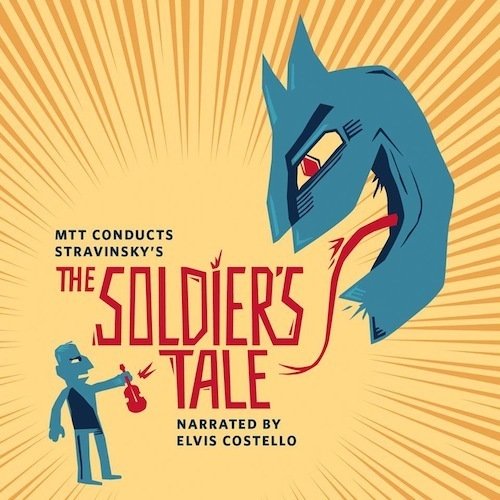
01.20.2015
“THREE GRAND OVATIONS. ONE CLOWN’S OPINION”
SFGATE: Joshua Kosman. January 17th 2015.
Elvis Costello and Stravinsky make a mismatch
Once a person becomes sufficiently famous and accomplished, the invitations start rolling in from far and wide — including projects that have nothing to do with their particular talents. You can spend nearly four decades, for instance, creating some of the most intricate, inventive and beautiful pop music of your era, and yet one day someone will ask you to narrate “The Soldier’s Tale” by Stravinsky.
It happened to Elvis Costello.
Why it happened is not easy to understand, but there he was on the stage of Davies Symphony Hall on Friday night alongside Michael Tilson Thomas and members of the San Francisco Symphony, not to mention a couple of genuine actors. The results took a fair bit of indulgence, even from Costello’s most dedicated and admiring fans.
I know this, because I am one. My devotion to his music dates from the 1977 release of “My Aim Is True,” his debut effort, and has never flagged for a moment in the intervening years.
Yet that enthusiasm has always been based on Costello’s extraordinary gifts as a songwriter and performing musician, as well as his keen critical brilliance as a musical thinker. It has nothing to do with his ability to recite either prose or poetry — which unfortunately turns out to be run-of-the-mill at best.
And Stravinsky’s pungent little folk tale with music needs more than that. The score, written for just seven instruments, is a bony creation in the composer’s neo-Classical vein, and Thomas and the instrumentalists made fine work of its angular rhythms and tart dissonances.
But the music intertwines with plenty of spoken text — telling a traditional story about a not-too-canny fellow who makes an ill-judged deal with the Devil — and any performance relies as much on dramatic values as on musical ones. On Friday, Malcolm McDowell was a wonderful Devil, plummy and insinuating, and Nick Gabriel from A.C.T. brought sweet naivete to the title role; Costello seemed to be more or less along for the ride.
There was more vivacity and delight to be had from the first half of the program, in which John Adams conducted the first Symphony performance of his “Grand Pianola Music” since its 1982 premiere on the long-gone New and Unusual Music series. Like the great “Harmonielehre” of a few years later, to which it serves as a sort of experimental precursor, this is a work that is as much about the act of clearing imaginative space as it is about the notes themselves.
The music is a mashup of Steve Reich, Beethoven’s “Emperor” Concerto and various pop strains, and it’s suffused throughout with the composer’s giddy sense of freedom. “Wait, you mean I’m allowed to do this?” you can hear him exult in every measure. “I can just write the kind of stuff I love?”
Of course he can — although that’s true in large part because he does it with such exuberance and skill. The piece is scored for two pianos (Marc-André Hamelin and Orli Shaham in this performance) as well as three singers (the fine ensemble Synergy Vocals) and a small stringless orchestra, and Adams combines his resources into a heady blend that is by turns translucent and rumblingly grand.
The only disappointment in this performance, which is being recorded for a later CD release on SFS Media, was the late-breaking decision to have Adams conduct rather than Thomas.
Adams is a capable enough conductor of his own music, but Thomas is a superb one. He boasts a deep understanding of the composer’s esthetic, and he has the podium technique to bring out intricacies that can easily get lost in performance. It seemed a shame to settle for the slightly unsteady rhythms of the first movement or the less than perfect balances in the second, when there was a conductor in the house who could have fixed those problems in an instant.